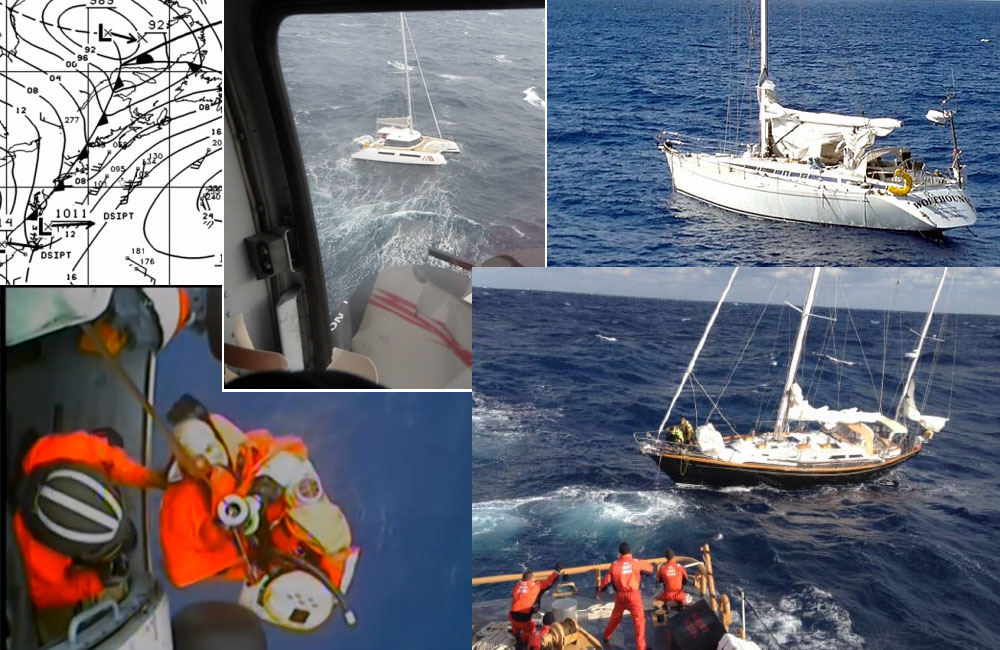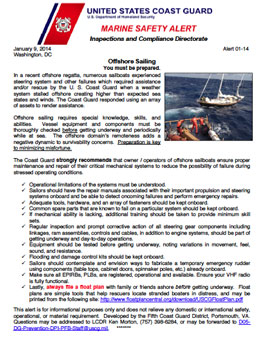The best response to the high number of recent vessel abandonments is to first recognize that accidents CAN happen to experienced sailors and then ask, “What can I learn from this?” While this is a big issue, today I want to focus in on regular inspections and routine checks which often get neglected when everything is going along smoothly.
A friend forwarded to me a statement recently issued by the US Coast Guard. In it the USCG recommends:
Regular inspection and prompt corrective action of all steering gear components including linkages, ram assemblies, controls and cables, in addition to engine systems, should be part of getting underway and day-to-day operations.
Checklists & Inspections!
Ben and I have a few voyage checklists and logs. When it came down to listing them all, I realized we have more than just a few! But don’t get overwhelmed. It is not too many. It has become routine for us, and many of them are only used on occasion.
- Pre-departure checklist – which is about 3 pages long.
- Ship’s Log – which has from 5 to 15 categories for each hourly entry depending on the type of voyage; coastal or offshore
- Packing List
- Regular Maintenance Schedule – engine, electronics, and vessel
- Medical Log – where we log the crew’s medications and health
- Long-Term project to-do list
- Weather Forecasting Log
- Morning Muster – a daily routine which systematically reviews short and long term plans as well as fosters positive shipboard culture, teamwork, and growth among the crew.
- Safety Equipment Essentials
- Watch Standing Orders
- Float Plan & Emergency Contacts
- Anchor Watch Duties
- Engine Checklist
- Fuel Log
- Spares Inventory
- Med Kit Inventory
- Boat Check
Boat Check
Our version of a Boat Check is required at every watch rotation – approximately every 3 hours (or more frequently as needed). The Boat Check is a list that includes full sensory inspections of bilges, electronics, engine & machinery spaces – logging hours, noting smells and other observations. We check belt tension, log bilge depth and battery level, test lights, and look for chafe. We check the heads, propane valves and connections, update weather reports, check seacocks, the steering system and rudder connections, coil/stow/secure stray lines on deck, check hatches, etc. The in-depth list takes less than ten minutes but requires the sailor to enter every space on board, walking from stern to bow, even checking aloft – with binoculars usually. If the circumstances such as weather compromise the safety of performing the inspection, we modify as needed. We log the Boat Check in the Ship’s Log and note anything of concern with a plan for monitoring or repairs if needed. This mission critical information is then transferred verbally to the next watch.
Help us refine our list! What would you add to the “Boat Check” checklist? What other safety routines do you perform? Share your ideas in the comments below to make this post a helpful read for anyone designing their sailing routines!




Comments 12
Ahoy Guys ,,, why do I get a pop-up note of “unauthorized access detected” when I click on ” USCG Safety Alert ” ?
As for your safety list ,,, I like and do try to abide by Brion Toss’s advice to , “Always try to build in a Reserve of Neglect ” with everything !
Thanks Douglas! Fixed the link.
Great post! I’m fond of my checklists too. I’d love to see the contents of these lists — I am sure it’d be very instructive.
Great article as usual and timely. I just got back from another short hop to Nassau on a Whitby 42 with friends of mine. Great trip and totally painless. The boat was well found, crew well briefed, we waited for the right weather window and used our CHECKLISTS. I passed the time listening to the VHF natter of other cruisers. What is obvious, both during this trip and on previous occasions is how MENTALLY unprepared most cruisers are for offshore work (even on such a short voyage from the US to the Bahamas). The VHF conversations varied from histrionics over vessels in close quarter situations to ridiculously naive questions to other boats about conditions on and off the banks. It was obvious that the callers had little faith in their boat or fellow crew. They seem to get some reassurance from conversations with other boats and services such as weather routers. They fail to realize that once the weather sh1t hits the fan you are very much on your own, that is until you decide to bail out. Don’t get me wrong, there are occasions when this is entirely the right decision (the recent catamaran abandonment seems to be a good example). At other times, especially during the storm, it is the wrong decision. To have confidence enough in yourself, your vessel and your crew you need experience. To get this experience you have to practice in heavy weather. The best and safest way to get this training is to take an extra experienced crew member with you when you venture offshore. All the buddy boats in the world won’t help you furl a sail or lash down an anchor when all hell breaks loose and your partner is frozen in terror.
I would second the request to post the checklists that you use. Would be very helpful as I develop/refine my own. Thanks!
Woah! Can’t wait for the book titled “One Simple Checklist” to come out! Add some downloadable templates of the checklists themselves to print at home, and give deeper explanations in a colourful and fun book as to why such and such list is important. Sprinkle it with “been there, done that, got the t-shirt” stories, and some great pictures , and I’m sure you’ve got yourself a best seller in no time! I sure would be a buyer!
Shackles. I know it’s inherent in your check of rigging, but I pay particular attention to shackles these days. I’ve had two that gave me warning they were going to fail, and thankfully I was mindful of hourly checks which caught them. I also give the boat a good walkabout just before sunset. What could go wrong during the night watch? It’s the perfect time to tuck in that reef, change course a bit, or whatever action is necessary to make the night pass a little bit smoother.
My other checklist was for solo sailing. Of all things, I had a “Me” checklist of things to knock off first thing in the morning. If at no other time, it was a chance to give me a good once over to see how my condition was, take my vitamins, put on whatever, etc. Sometimes the day catches up quicker than you can get ahead, so it was a welcome practice.
Great post! If you’re looking to replenish your safety equipment check out this link http://www.sailingproshop.com/safety
They have pretty good deals! Happy sailing!
Great advice, Teresa. Going to sea or just for the day in a boat that you don’t know if everything works can go from embarrassing to dangerous. Great article. I still sail with the attitude that I will only leave my boat if I have to step up into the life-raft.
Hi!
Thanks very much this is a fantastic checklist. I am a delivery skipper myself and find them invaluable to ensuring EVERYTHING is covered. Its too easy to miss small details, which however minor they seem on their own. Its the conglomeration of all these small issues that cause problems at sea!
P.S. Here’s a checklist I use for wintering and laying up of yachts at the end of season!
http://www.sailingyachtdelivery.com/yacht-wintering-laying-up.html
I might add “the hand off”. This would occur with a changing of the watch when the boat check is briefly reviewed and any issues that might need watching, i.e., engine running a little warm, are communicated between the old and new watch.
You always want to make sure to check and double-check before you hit the water. This is a great list outlining everything that needs to be checked. Thanks for the post.